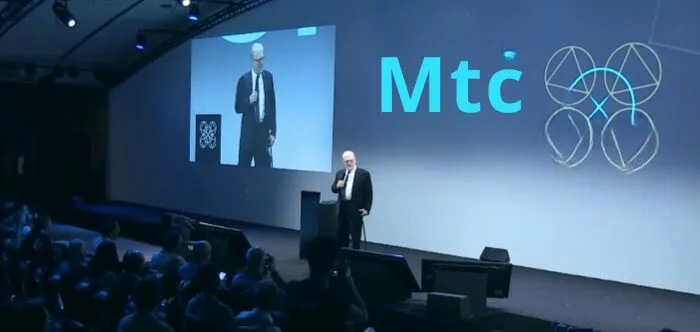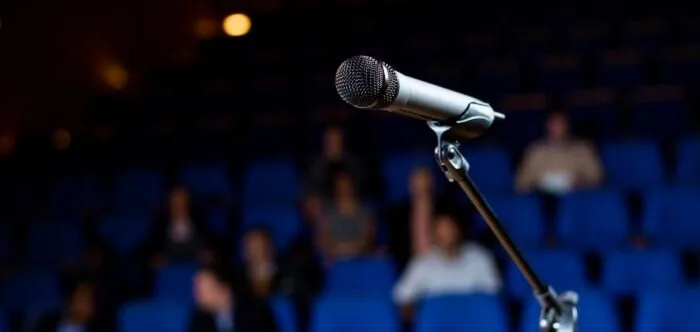Effective communication is the cornerstone of any successful conference, and the microphones play a crucial role in this. Now you might be thinking, what kind of mic is used in the conference?
Conferences typically utilize a range of microphones, including ceiling-mounted ones for overall room coverage, versatile wireless bodypack/lavalier and handheld microphones for mobility, lectern gooseneck microphones for speakers, and both wired and wireless table-mount gooseneck microphones for panel discussions.
These are often integrated into a mix-minus voice-lift array, ensuring crystal-clear audio distribution. For a deeper dive into how each of these microphones serves a unique purpose in a conference setting, continue reading as we explore the specifics and advantages of each type.
What Happens at Conferences?
Conferences are active gatherings where professionals from various fields gather to share knowledge and network. Conferences often feature keynote speeches, panel discussions, and workshops led by industry experts. By participating in these conferences internationally, attendees can gain insights, engage in thought-provoking conversations, and explore new trends and innovations.
Networking is a significant aspect of conferences, offering opportunities to connect with peers, mentors, and potential collaborators. Breakout sessions and social events facilitate these interactions, bringing up professional relationships and community building. It’s a space where ideas are exchanged, and future partnerships can be formed.
The focus of a conference can vary widely, from academic research to business strategies, depending on the industry. Interactive exhibits and vendor booths often showcase the latest products or services. Ultimately, attendees leave with enhanced knowledge, new contacts, and a sense of inspiration.
How Do Communication Elements Impact Conference Success?
A successful conference hinges on effective communication, which encloses various elements that collectively ensure a smooth and impactful event. Without choosing the right mic for conference, how can you expect the speakers to communicate to their attendees properly? These elements range from the clarity of messages to the technology used, each playing a critical role. Understanding and optimizing these facets can greatly enhance the conference experience.
- Clarity of Message: Clear, concise messaging is essential in conferences to convey complex ideas effectively. It helps in keeping the audience engaged and informed.
- Quality of Audio/Visuals: High-quality audio and visuals are crucial for delivering presentations and aiding comprehension. They prevent misunderstandings and enhance the overall experience.
- Interactivity and Engagement: Encouraging audience participation through Q&A sessions or interactive tools keeps attendees involved and attentive. This engagement promotes a more dynamic and memorable conference.
- Effective Moderation: Skilled moderators can guide discussions smoothly, ensuring that sessions remain focused and productive. They play a key role in facilitating dialogue and managing time.
- Cultural and Language Considerations: Acknowledging and addressing cultural and language diversity ensures inclusivity and broader understanding. It’s important for global conferences with diverse attendees.
- Follow-up and Feedback: Post-conference follow-ups and collecting feedback are vital for continuous improvement. They help in understanding the impact and areas needing enhancement.
The success of a conference is deeply rooted in how well these communication elements are executed. They work in unity to create an environment conducive to learning, networking, and collaboration. Effective communication is not just about speaking but creating a resonant experience for all participants.
What Kind of Mic Is Used in the Conference?
Conferences are hubs of knowledge sharing and networking, where clear audio communication is paramount. The right choice of microphone can significantly enhance the effectiveness of the presentations and discussions. Here, we’ll explore what kind of mic is used in the conference.
Ceiling-Mounted Microphones
Ceiling-mounted microphones are ideal for capturing audio in large rooms. They are strategically placed to pick up sound from all directions, ensuring that every voice is heard clearly. This type of microphone minimizes the need for individual mics, creating a clutter-free environment that is easy to manage. They are especially useful in interactive sessions involving audience participation, as they allow for seamless communication without the distraction of handheld devices.
Wireless Bodypack/Lavalier Microphones
Wireless Bodypack or Lavalier microphones offer speakers the freedom to move around during their presentations. These small, clip-on mics are discreet and provide excellent sound quality, making them perfect for presenters who prefer to walk around or interact closely with the audience. Their portability makes them a popular choice in dynamic conference environments, where speakers need to engage with participants without being tethered to a microphone. This flexibility enhances the overall presentation experience for both the speaker and the audience.
Handheld Microphones
Handheld microphones are a classic and versatile option used in various settings. They are ideal for Q&A sessions, allowing easy passing between participants without interrupting the flow of conversation. Their familiar form factor makes them comfortable for first-time users, helping to reduce any anxiety about speaking in front of a crowd. They are also great for spontaneous speeches or panel discussions, as they can be easily grabbed and used by anyone on stage.
Lectern Gooseneck Microphones
Lectern gooseneck microphones offer flexibility and precision for speakers at podiums. They are commonly used for keynote speeches, providing a stable and reliable audio source. Their adjustable neck allows speakers to position the mic comfortably at their desired height and angle, ensuring optimal sound pickup. This type of microphone is favored for its stability and ease of use during formal presentations, helping to maintain a professional atmosphere.
Table-Mount Gooseneck Microphones
Table-mount gooseneck microphones are excellent for panel discussions and collaborative settings. They are typically wired or wireless and offer clear sound pickup for each speaker. Positioned on tables, they provide each panelist with a dedicated microphone, making it easy for everyone to contribute. This setup facilitates a smooth flow of conversation among multiple speakers, ensuring that all voices are heard during discussions.
The selection of microphones in a conference is crucial to ensure clear and effective communication. Each type of microphone serves a specific purpose, catering to different aspects of the conference, from keynote speeches to interactive panel discussions. Understanding their unique features and applications helps in creating an environment conducive to successful communication and engagement. You can also arrange Live Translation at Conferences to uplift the quality of the event.
Considerations While Using a Conference Microphone
In conferences, microphones are more than just devices; they are vital tools for communication. Proper usage and consideration are key to ensuring that every word is heard and understood. Here, we dive into the crucial factors to consider when utilizing conference microphones.
- Placement and Positioning: Proper positioning of microphones ensures optimal sound quality. It’s essential to adjust them according to the speaker’s distance and movement.
- Sound Check and Volume Control: Conducting a sound check before the event is crucial for identifying and rectifying audio issues. Adjusting volume levels to suit the room’s acoustics is equally important.
- Minimizing Background Noise: Selecting a location with minimal ambient noise features clarity. Use directional microphones to focus on the speaker and reduce background interference.
- Compatibility with Other Equipment: Ensure the microphone is compatible with the existing sound system. This prevents technical issues and maintains sound integrity throughout the conference.
- Battery Life for Wireless Microphones: For wireless microphones, checking and maintaining battery life is essential. This prevents interruptions during speeches or discussions.
- Hygiene Considerations: In shared microphone settings, hygiene becomes important. Regular cleaning or using disposable covers can prevent the spread of germs.
In essence, attention to these considerations can greatly impact the effectiveness of communication in conferences. By precisely addressing these aspects, one ensures that the focus remains on the content being delivered, raising a seamless and productive conference experience.
Essential Tips for Selecting the Right Conference Mic
Choosing the right microphone for a conference is a crucial decision that can significantly impact the success of the event. The ideal microphone should cater to the specific needs of the conference, ensuring clear and effective communication. Here, we’ll explore some essential tips to help you select the perfect conference microphone.
Assessing Room Size
Consider the size of the room you have selected for your conference when choosing a microphone. Larger rooms might need powerful, strategically placed mics for even sound coverage. Smaller venues can often be well-served by simpler, less powerful microphone setups.
Speaker’s Mobility Needs
Consider the mobility needs of the speakers. Wireless Lavalier mics are perfect for presenters who move around. Handheld microphones suit interactive sessions, allowing easy passing between speakers. For stationary speakers, a lectern microphone offers stability and quality.
Type of Conference
The conference type dictates the microphone choice. Panel discussions benefit from table-mount gooseneck microphones for each speaker. For keynotes, a high-quality lectern microphone ensures that speeches are delivered clearly. Interactive workshops may require handheld mics for audience participation.
Quality and Reliability
Invest in high-quality, reliable microphones. Good sound quality keeps the audience engaged and conveys professionalism. Having reliable and essential AV equipment for conference success minimizes technical glitches, ensuring smooth proceedings. Don’t compromise on quality for cost when it comes to conference mics.
Ease of Use
Choose microphones that are user-friendly. Complicated setups can lead to delays and technical issues. Simple, intuitive microphone systems are preferable for smooth operation. This is especially important in conferences with multiple speakers.
Testing and Compatibility
Always test microphones beforehand. Ensure they are compatible with the existing audio system. Conduct sound checks to adjust settings for optimal performance. This step helps in avoiding unexpected issues during the conference.
The right microphone can make a world of difference in the effectiveness of a conference. By considering these key factors, you can ensure that your choice developes communication, engages the audience, and contributes to the overall success of the event. Remember, the microphone is not just a tool, but a bridge connecting speakers and the audience.
Frequently Asked Questions
In this section, we address common questions about different types of microphones and their uses. Understanding the various options available can help you choose the right microphone for your needs, whether for video conferencing, public speaking, or recording. Here are some FAQs to guide you in making informed decisions about microphone selection.
What Are the 4 Main Types of Microphones We Use?
The four main types of microphones are dynamic, condenser, lavaliere, and shotgun. Dynamic mics are great for live settings, while condensers excel in studio environments. Lavalier mics are tiny, clip-on options for interviews, and shotgun mics focus on sound from specific directions, making them perfect for video and film work.
Which Microphone Is Best for Video Conferencing?
The best microphone for video conferencing is a USB condenser microphone. It offers excellent sound quality and clarity, capturing voices crisply while minimizing background noise. Alternatively, a Lavaliere mic is great for those who prefer hands-free convenience. Either choice ensures participants sound professional and engaged during virtual meetings.
What Kind of Microphone Is Used in Public Speaking?
For public speaking, handheld dynamic microphones are commonly used because they are durable and effective at picking up voices while minimizing background noise. Lavalier microphones are also popular for speakers who need freedom of movement, as they clip onto clothing and provide a discreet way to capture clear audio without distraction.
Which Type of Microphone Is Usually the Most Accurate?
Condenser microphones are usually the most accurate type, thanks to their sensitivity and wide frequency response. They capture subtle details and nuances in sound, making them ideal for studio recordings and vocals. Their ability to pick up a broad range of frequencies ensures a clear, rich audio experience for listeners.
How Do I Choose a High-Quality Microphone?
To choose a high-quality microphone, consider your intended use—live events, studio recordings, or video conferencing. Look for a microphone with good sensitivity and frequency response, read reviews, and test it if possible. Also, prioritize build quality and ease of use, ensuring it fits your specific needs and increases your sound experience.
Bottom Line
In conferences, the choice of microphones is not just about technology; it’s about bringing up seamless communication. What kind of mic is used in the conference is a question that unravels a world of microphone diversity. From ceiling-mounted solutions for room-wide clarity to portable wireless options enabling speaker mobility, there’s a microphone customized to every conference need.
In this complex soundscape, lectern and table-mount gooseneck microphones take center stage, providing precision and stability during presentations and discussions. Beyond the technical aspects, it’s about creating an environment where voices are amplified and ideas resonate.
So, when considering the perfect microphone for your conference, remember that it’s more than just a tool; it’s the conduit through which knowledge flows, connections are forged, and inspiration is ignited.








